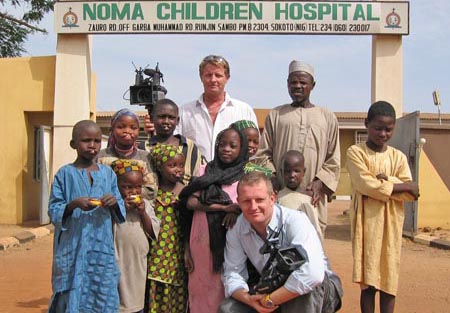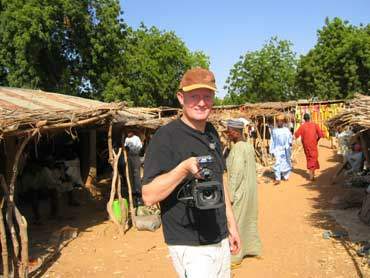
GET A LIFE
by MICHAEL KLINT
Zwei Filmemacher erfahren von einer lethalen, unbekannten Krankheit, die Kinder in einem entlegenen Teil Afrikas befällt. In staubigen Dörfern am Rande der Sahara finden sie die Opfer dieser schrecklichen Krankheit. Bald schon müssen sie erkennen, dass sie diese Realität nicht wie üblich professionell ablichten können, weil sie persönlich vom Ringen um die Rettung der Kinder betroffen sind. Während der Aufnahmen sind sie gezwungen zu kritischen Zusammenhängen einen Standpunkt zu vertreten: Dritte Welt Armut, Ausbeutung der Schwächsten, und zum endgültigen am Leben, dem Tod. Gleichzeitig ist es ein Film über das moralische Empfinden von Filmemachern.
Two filmmakers discover an unknown, lethal disease, that hits children in the remote parts of Africa. In dusty villages in the outskirts of the Sahara desert, they find the victims of this horrible illness. The filmmakers now think that they will simply portray reality professionally, as they usually do. But instead, they are personally drawn to the struggle of saving the children. During the shooting they are forced to take a stand in crucial dilemmas: Third World poverty, exploitation of the weakest and most ill people in the developing countries, and the ultimate in life; Death. At the same time it is a film about the morale of filmmakers. The name of the disease is Noma. It strikes the weakest, the poorest, especially in the countries in the southern Sahara. Every year it strikes thousands of malnourished children, whose immune system is weakened. The compromised immune system causes ordinary bacteria, which we all have in our mouths, to suddenly develop in an alarming pace. It starts with a little brown dot on the cheek or by the mouth, and from here the rottenness rapidly spreads and literally eats up the face. Within one week, large pieces of the face has disappeared, usually causing the child to die. Some survive, but with horrible deformities in the face however.
The film takes place at a hospital in northern Nigeria. At The Noma Children Hospital, which is run by a small Dutch-German aid organization, the doctors struggle to save the children that are brought in. The disease can be stopped with simple antibiotics. The children, who survive, undergo plastic surgery at the hospital, so their faces can become just moderately normal again.
The film discusses the gap between rich and poor, and the difference between how and where a life is lived. Some of us are given life as a gift. And we should probably be more appreciative about it, than we generally are: Get a Life, we often say to those, who complain undue about the petty problems of life here in the rich part of the world. There are people who have 'real' problems. People for whom life is not granted, but a curse. It is simply all about, where in this earth we are born.
The situation of the Noma-victims cannot be portrayed without seeing the dividing line between life and death. There is a fine border line. Should a 3-year old child, who is missing half of its face and who is in unbearable pain, not rather have peace and die, when the mother has already turned her back on the child a long time ago. It happens everyday in Africa, where 8 out of 10 Noma-victims die.
The films director Michael Klint says:
- We, who have made the film, will never forget the images we recorded
at the hospital and in the surrounding villages. We can still smell the
rottenness in out bad dreams. And in our optimistic moments, we hope that
the children can recieve some attention with this film.
http://www.trust-film.dk
Title: GET A LIFE
Original Title: GET A LIFE
Director(s): Michael Klint
Sound Editor: Morten Raarup
Editor: Morten Raarup
Genre: Documentary
Length: 58 mins
Format: Digi Beta
Screen Ratio: 4:3 1:1,85
Sound: Stereo
Year of Production: 2003
Producer(s): Carsten Holst, Karoline Leth
Production Company: Zentropa Real
Co-Financed by: YLE, NRK, SVT, DR, Norsk Filmfond, NFTF, Media

Get the Life by the Danish documentary filmmaker Michael Klint was shot according to little known rules of film "realism", paraphrasing the famous "Dogme 95". The author of this docu-dogme is the perpetual provocateur Lars von Trier, who came with it in 2001. The same year, Zentropa production company, along with the Danish Film Institute and Danish Broadcasting Television chose six documentary filmmakers to make a film responding to given rules.
The documentary rules of Trier´s manifesto follow his previously stated attitudes ("Dogumentarism relives the pure, the objective and the credible. It brings us back to the core, back to the essence of our existence. The documentary and television reality that has become more and more manipulated and filtered by camera people, editors and directors must now be buried."), nevertheless, Get a Life captures something crusial about the authorial attitude to a theme - to the misery and hunger of the Third world in this case.
A provocative work mirrors the dilemmas each filmmaker
or journalist encounters when trying to mediate such taboo topics to international
audiences, a reflection of the issue of authorship as such…
http://www.dfi.dk/sitemod/moduler/index_english.asp?pid=21540
Michael Klint made his shocking, self-reflective documentary
"Get a Life" according to the special set of rules known as
'Dogumentary'.
Af FILM / Michael Klint
Publiceret i FILM #39, November 2004
In 2001, Lars von Trier issued a set of rules for making documentaries
along the lines of the familiar Dogme manifesto for fiction films. The
same year, the production company Zentropa Real, in collaboration with
the Danish Film Institute and the Danish Broadcasting Corporation, asked
six Scandinavian filmmakers to make films according to the socalled Dogumentary
code. The intention was to return the documentary to real life.